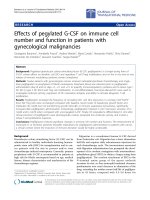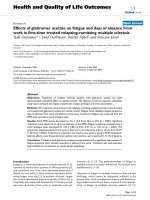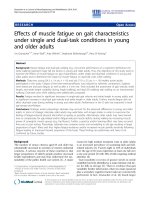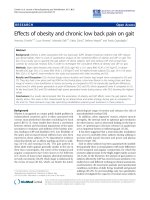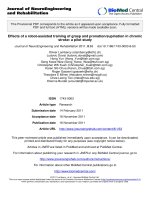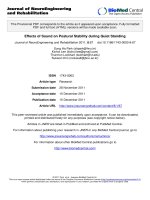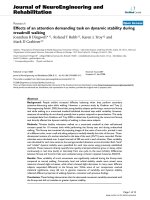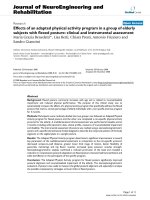báo cáo hóa học:" Effects of GnRH agonist treatment on steroidogenesis and folliculogenesis in the ovary of cyclic mice" pot
Bạn đang xem bản rút gọn của tài liệu. Xem và tải ngay bản đầy đủ của tài liệu tại đây (2.88 MB, 13 trang )
RESEARC H Open Access
Effects of GnRH agonist treatment on
steroidogenesis and folliculogenesis in the ovary
of cyclic mice
Padmasana Singh, Amitabh Krishna
*
Abstract
Background: GnRH analogs (both agonist and antagonist) have been extensively used for clinical applications,
following the discovery of its direct effects on ovary. With regard to the direct actions of GnRH agonist on ovary,
conflicting data are reported. The mechanism through which GnRH agonist affect gonadal functions is still obscure.
The aim of present study was thus to investigate the effects of treatment with different doses of GnRH agonist, in
vivo and in vitro, on morphological, physiological and functional changes in the ovary of cyclic mice.
Methods: To find out the effect of GnRH agonist on ovarian activity, cyclic mice were treated with differe nt doses
for 8 days and its effect on folliculogenesis (morphological changes in follicle, Estrogen receptor, progesterone
receptor), steroidogenesis (circulating progesterone level, StAR, LH-receptor, 3b-HSD), luteinization (Morphology of
corpus luteum) and apoptosis (caspase-3, PARP) were observed. To find the in vitro effects of GnRH agonist with or
without LH on ovary of mice, changes in the expression of LH-receptor, estrogen receptor, progesterone receptor,
3b-HSD in the ovary and progesterone level in the culture media were investigated.
Results: GnRH agonist treatment produced significant changes in ovarian mass, circulating steroids level and
ovarian follicular development, steroidogenesis and apoptosis in the mice. GnRH agonist also caused dose
dependent histological changes in follicular development and luteinization. The mice treated with different doses
of GnRH agonist showed biphasic effects on steroid synth esis due to its effects on ovarian expression of LH-
receptor, StAR, and 3b -hydroxysteroid dehydroge nase proteins. The high dose showed stimulatory effect, whereas
pharmacological dose showed inhibitory effect on ovarian follicular development and steroidogenesis. The in vitro
study generally showed inhibitory effects of GnRH agonist on ovarian activities, which may be reversed by the
presence of LH.
Conclusion: Both inhibitory and stimulatory effects found in the present study suggest that GnRH agonist is a
versatile tool in the therapy of a variety of gynecological and non-gynecological conditions. This study suggests
that the outcome of direct effect of GnRH-ag on ovary depends on LH-responsiveness.
Background
The decapeptide gonadotropin-releasing hormone
(GnRH) is a key regulator of sexual maturation and
reproductive functions in mammals. It is secreted from
the hypothalamus in a pulsatile manner a nd stimulates
the synthesis and release of gonadotropins, follicula r sti-
mulating hormone (FSH) and luteinizing hormone (LH),
via specific GnRH receptor located on gonadotrope
cells. These gonadotropins in turn, regulate various
gonadal functions, such as folliculogenesis , steroidogen-
esis and apoptosis.
Besides pituitary, the GnRH receptor gene is also
expressed in extrapituitary sites including ovarian granu-
losa cells of rat [1] and human [2-4]. Several lines of evi-
dences suggest that ovarian GnRH receptor transcripts
are identical to those found in the anterior pituitary
gland [1]. A number of biological responses have been
observed upon activation of GnRH receptor in the
ovary. The actions of GnRH in ovary vary with the
developmental stages of the follicles. GnRH exerts a sti-
mulatory action on preovulatory follicles by inducing
* Correspondence:
Department of Zoology, Banaras Hindu University, Varanasi 221005, India
Singh and Krishna Journal of Ovarian Research 2010, 3:26
/>© 2010 Singh and Krishna; licensee BioMed Central Ltd. This is an Open Access article distributed under the terms of the Creative
Commons Attribution License ( , which permits unrestricted use , distribution, and
reproduction in any medium, provided the original work is properly cited.
oocytes maturation [5] and follicle rupture [6]. On smal-
ler follicles, however, the effects of GnRH are inhibitory
in nature as GnRH treatment decreases steroidogenesis
and gonadotropes receptor concentration [7]. GnRH
may also play a role in the induction of follicular atresia
intheratovary[8].Thus,theactionsofGnRHwithin
the ovary are diverse.
Many derivatives of GnRH, known as GnRH analogs,
have been synthesized in an attempt to develop more
potent GnRH compounds for therapeutic use. A large
number of structural analogs of GnRH have been
synthesized. Both GnRH agonist (GnRH-Ag) and GnRH
antagonist (GnRH-Anta) with enhanced biological
potency have been developed and studied extensively
[9]. Clinically some of these synthetic analogs have been
used as an effective treatment of hormone dependent
reproductive disorders including infertility, endometrio-
sis, polycystic ovary s yndrome (PCOS), precocious pub-
erty, and uterine fibroids etc, whereas others have
widely adopted in controlled ovarian hyperstimulation
regimes for assisted reproductive techniques [10]. In
addition to the therapeutic applications, GnRH analogs
are predicted to be used as new generation male and
female contraceptives in conjunction with steroid hor-
mone replacement [11,12].
The extensive clinical applications of GnRH analogs
have attracted the investigations on direct effect of
GnRH-Ag on ovarian activity. However, only limited
and conflicting information exists about the effect of
GnRH analogs on ovarian morphological and functional
features [10,13]. In granulosa cells collected from
human for in vitro fertilization (IVF) program, some
authors found an increased ovarian steroidogenesis
induced by GnRH-Ag in vitro, which could not be con-
firmed b y others. But some investigators have proposed
that inhibitory effect is due to the down regulation of
gonadal gonadotropin receptor cause d by the increase
release of LH secretion [14], while others feel that
GnRH and its analogs act directly on the gonad to inhi-
bit ovarian functions [15].
GnRH is now regarded as an important paracri ne and
autocrine factor in the ovary [16]. However, the
mechanism through which GnRH analogs affect gonadal
functions in intact cyclic animal is still obscure. There is
considerable debate about the utility of GnRH agonist in
treatment for infertility, cancer and assisted reproduc-
tion technique. Therefore, it has been cautioned that
direct effects of GnRH analogs should be explored in
more detail prior t o their large-scale introduction for
the various therapeutic uses. To the best of our knowl-
edge, the mechanism by which GnRH-analogs affects
various ovarian activities, such as follicular development,
luteinization and steroido genesis, has not so far been
investigated in intact cyclic animal. In order to explore
this, t he morphological and physiological changes, such
as changes in steroid receptors, and steroidogenic and
apoptotic factors in the o vary was investigated following
in vivo and in vitro administration of GnRH agonist in
the intact cyclic mice.
Methods
Animals
All the experiments were conducted in acc ordance with
principles and procedures of animal act, 2002 of Gov-
ernment of India, approved by Departmental Research
Committee, Banaras Hindu University. Mice (Mus
musculus) of Parkes Strain were housed under constant
condition of temperature and humidity in a photoperio-
dically control led room (L:D 12:12) of our animal house
and were provided with commercial food (Pashu Aahar
Kendra, Varanasi, India) and tap water ad libitum. Adult
(10-12 week old) female mice of nearly similar body
mass and exhibiting at least two consecutive 4-5 day
cycles were used in this experiment. Regularly cycling
mice were randomly allocated into seven groups.
Treatment
Mice were given single intramuscular in jection of differ-
ent doses (1 μg, 5 μg, or 25 μg/day) of GnRH-Ag
([DTrp
6
,Pro
9
-NEt] GnRH) dissolved in normal saline,
daily for 8 days (n = 8-10 in each group). The mice in
control group (n = 10) received vehicle only. The treat-
ment with GnRH-Ag was started on proestrus morning
for each mouse to maintain the uniformity. The animals
were sacrificed by decapitation under mild anaesthesia
(anaesthetic ether) within 30 min a fter last injection.
Body mass of each mouse was recorded before killing.
Ovaries were dissected out, cleaned from any adhered
fat tissue and oviduct, and weighed. The ovary of one
side from each animal was snap frozen and kept at
-40°C until protein extraction for immunoblots and the
contralateral ovary was fixed in bouin’s fixative at room
temperature for histological evaluation of follicular
development. Serum was separated from blood and
stored at -20°C until assayed for progesterone ( P
4
)and
estradiol (E
2
).
Histology and counting of follicles
Bouin’s fixed ovaries were dehydrated, embedded in par-
affin wax, sectioned serially (5 μm) and stained with
hematoxylin and eosin. The stained sections were then
observed under a Nikon Eclipse E200 Microscope
(Nikon, Tokyo, Japan). The number of different types of
follicles (both preantral and antral excluding primordial)
and corpus luteum in the ovaries were counted by
examining every fifth serial section of each ovary and
then counting the follicles whose plane of section passed
through the nucleolus of the oocytes. Preantral and
Singh and Krishna Journal of Ovarian Research 2010, 3:26
/>Page 2 of 13
antral follicles were classified according to the number
of granulosa cell layers and antrum formation [17]. The
numbers of atretic follicles were also counted. Pyknotic
cell nuclei in the granulosa cells or changes in the
oocytes morphology (e.g. deformed sha pe, vacuolation,
loss of nuclear membrane and/or fragmentation) charac-
terized the follicular atresia [18].
In vitro study
To determine the direct effects of GnRH-Ag, an in vitro
study was performed in accordance to Singh et al (2010)
[19]. Proestrus ovaries were culture as it contain s many
maturing follicles as well as to maintain uniformity in
the stage of all the ovaries used in every group. Culture
medium was a mixture of Dulbecco Modified Eagle’s
Medium and Ham’ s F-12 ( 1:1; v:v) Himedia, Mumbai,
India) containing 100 U/ml penicillin, 100 μg/ml stre p-
tomycin and 0.1% BSA (Sigma Chemicals Co., St Louis,
USA). After initial incubation for 2 h at 37°C culture
medium was discarded, and ovari es (one per tube) were
finally cultured in 1 ml of medium in a humidified
atmosphere with 95% air and 5% CO
2
for 24 h at 37°C.
Ovaries cultured under these conditions appeared
healthy and did not show any sign of necr osis after 24 h
culture. The treatment of GnRH-Ag (10 ng and 100 ng)
was given either alone or together with LH (100 ng/ml).
Control groups received 10 μl of phosphate buffered sal-
ine/ml of medium/tube. Each treatment and control
groups were run in triplicate and the experiment was
repeated two times. Ovaries were collected at the end of
culture, washed several times with PBS and kept frozen
at -40°C for immunoblot study. Media was saved at
-20°C until assayed for P
4
and E
2
.
Radioimmunoassays for Progesterone (P4) and Estradiol
(E2)
Steroids in the serum and culture medium were mea-
sured directly by radioimmunoassay using commercial
kits (Immuno tech, Marseille, France). Assays for P4 and
E2 in the serum/culture medium were performed with
50 μland100μl respectively, as per manufacturer’s
instructions. Bound radioactivity was measured for one
minu te in Gamma Counter (Beckman, Genev a, Switzer-
land). Standard, zero tubes and blank tubes were run in
parallel with the samples. Intra assay coefficient of varia-
tion for all the assays were less than 12%.
Immunoblotting
Western blotting was performed in accordance with
Singh et al (2010) [19]. 10% homogenate of ovaries was
prepared. Equal amount of protein (15 to 50 μg) as
determined by Lowry’s method [20] was loaded on SDS-
PAGE (8-12%) for electrophoresis and transferred elec-
trophoretically to polyvinylidene difluoride membrane
(PVDF, Immobilon-P; Millipore, Bedford, MA, USA).
Blotted membranes were blocked and incubated with
appropriate diluti on of primary antibodies (LH-receptor
and progesterone receptor at a dilution of 1:1500; StAR
at a dilution of 1:2000; 3b-HSD and estrogen-receptor-a
at a dilution of 1:500; Caspase-3 and PARP at a dilution
of 1:1000. M embranes were washed with PBS-Tween 20
buffer and then incubated for 30 min either with anti-
rabbit or anti-mouse IgG-horse radish pero xidase anti-
body. Immunodetection was performed with enhanced
chemiluminescence detection system (Bio Rad, Hercules,
USA). Experiments were repeated three times with the
same result. X-ray films were later scanned and then
quantified by densitometry (Image J vs 1.36, NIH, USA).
Quality of l oading and transfer was assessed with Pon-
ceau S staining and/or b-actin. All immunoblots were
normalized to b-actin.
Statistical analysis
Thedatawereanalyzedbyone-wayANOVAfollowed
by Duncan’s multiple range post hoc test. The difference
were considered significant if P < 0.05 or 0.01.
Results
Effect of GnRH-Ag treatment on body and ovarian mass
(Table 1)
No significant change in the body mass was observed
while ovarian mass were reduced significantly (P < 0.05)
with all the doses of GnRH-Ag after 8 days of treatment
as compared with controls.
Effect of GnRH-Ag treatment on Reproductive cyclicity
Vaginal cytology in control mice showed a regular 4-5
day estrous cycle during the period of the experiment.
GnRH-Ag treated mice showed no marked changes in
vaginal cytology after 8 days of treatment.
Effect of GnRH-Ag treatment on ovarian histology and
follicular development (Table 1; Figure 1)
ThemicetreatedwithGnRH-Agshowedsmallerovar-
ies, as was also apparent by their mass (Table 1). Total
numbers of healthy and atretic follicles in the GnRH-Ag
treated ovaries varies significantly and they revealed a
marked variation in the pattern of follicular develop-
ment, ovulation and luteinization. The ovaries of control
mice showed healthy and large corpus luteum together
with numerous small and medium sized antral follicles
(Figure 1A). The mice treated with the low dose (1 μg)
of GnRH-Ag showed many healthy and atretic antral
follicles and corpus luteum in the ovary (Figure 1B).
Thehighdose(5μg) of GnRH-Ag showed stimulatory
effects on the ovary. The ovaries showed a significant
increase in the number and size of corpora lutea as
compared with the control (Figure 1C). These newly
formed corpora lutea contained morpholo gically healthy
Singh and Krishna Journal of Ovarian Research 2010, 3:26
/>Page 3 of 13
luteal cells (Figure 1E). A number of healthy antral folli-
cles (Figure 1D) were also seen though their number
declined significantly as compared with the control. The
number of atretic follicles was also significantly higher
in mice treated with high dose of GnRH-Ag as com-
pared with the control. However, the treatment with
pharmacological dose of GnRH-Ag (25 μg/day) showed
extensive degenerative changes in the ovary in granulosa
cells, theca cells and oocytes. The major ity of the granu-
losa cells showed enlarged and vacuolated nuclei but the
nuclei of some granulosa cells were condensed like
pyknotic cells. The theca cells appeared thin and fibrou s
(Figure 1G). The oocytes of many preantral and antral
follicles showed degenerative changes. The oocytes of
these abnormal follicles were extensively vacuolated
(Figure 1H). The degenerative effect is less marked in
luteal cells as compared with the granulosa cells.
Effect of in vivo treatment of GnRH-Ag on serum steroid
concentration and expression of steroid receptors in the
ovary (Figure 2)
Serum P
4
and E
2
concentrations of the control and
GnRH-Ag treated mice are shown in Figure 2. Particu-
larly, the mice treated with high dose of GnRH-Ag
showed significant (P < 0.01) increase in the circulating
progesterone level while mice treated with pharmacolo-
gical dose o f GnRH-Ag sho wed a s ignifi cant (P < 0.01)
decrease in the circulating estradiol concentration as
compared with the control mice.
Western blot analysis of progesterone receptor (PR) in
the ovary gave two immunoreactive bands at ~85 kDa
(PR-A) and ~120 kDa (PR-B) and estrogen receptor-a
(ERa)gavesingleimmunoreactivebandat~55kDa
(Figure 2C).
Treatment with low and high doses of GnRH-Ag
showed a significant (P < 0.01) increased ovarian expres-
sion of both the isoforms of PR while the treatment
with pharmacological dose of GnRH-Ag showed signifi-
cant (P < 0.01) increa sed expression of only PR-A, but
not of PR-B in the ovary (Figure 2D). Treatment with
only pharmacological dose of GnRH-Ag showed
significant (P < 0.01) decreased expression of ER-a in
the ovaries as compared with the control mice (Figure
2E).
Effect of in vivo treatment of GnRH-Ag on expression of
LH receptor, steroidogenic acute regulatory protein
(StAR) and 3beta-hydroxysteroid dehydrogenase (3b
-HSD) proteins (Figure 3)
Changes in ovarian expression of luteinizing hormone-
receptor (LH-R), steroidogenic acute regulatory protein
(StAR) and 3b-hydroxysteroid dehydrogenase (3b -HSD)
proteins are used as marker of steroidogenic activity in
the ovary. Western blot analysis of ovarian LH receptor,
StAR, and 3b -HSD proteins in the mice treated with
GnRH-Ag showed immunoreactive band at ~70 kDa,
~30 kDa and ~45 kDa respectively (Figure 3A).
The mice treated with the low dose of GnRH-Ag
showed no significant variation while high dose treat-
ment showed significantly (P < 0.01) increased expres-
sion of LH-R protein in the ovaries as compared with
the control. The pharmacological dose treatment of
GnRH-Ag showed decline in immunoreactivity for LH-R
as compared with the high dose (Figure 3B).
The mice treated with all the three doses of GnRH-Ag
showed significantly (P < 0.01) increased expression of
StAR protein in the ovary as compared with the control,
but the increase is more pronounced in high dose
(Figure 3C).
3b-HSD protein increases (P < 0.01) significantly in
the ovary of mice treated with low and high doses
of GnRH-Ag while pharmacological dose showed no
significant variation as compared with the control
(Figure 3D).
Effect of in vivo treatment of GnRH-Ag on expression of
caspase-3 and poly ADP-ribose polymerase (PARP)
proteins (Figure 4)
Changes in ovarian expression of caspase-3 and poly
ADP-ribose polymerase (PARP) proteins are used as
marker of apoptosis in the ovary. Western blot analysis
of caspase-3 gave single immunoreactive band at
Table 1 Effect of GnRH agonist on body mass, ovarian mass and ovarian follicles/CL of mice
Treatment Body mass (g) Ovarian mass (mg) Type of follicles
Early preantral Late preantral Early antral Late antral Atretic Corpus luteum
Control 28.20 ± 0.70 6.64 ± 0.29 70.00 ± 9.61 4.50 ± 2.17 20.75 ± 2.43 10.00 ± 0.00 13.00 ± 1.96 4.00 ± 0.58
GnRH-Ag
(1 μg/day)
28.12 ± 0.47 5.09 ± 0.52* 63.00 ± 3.60 4.34 ± 2.34 27.34 ± 8.37 7.33 ± 3.18 10.67 ± 2.96 3.50 ± 0.28
GnRH-Ag
(5 μg/day)
26.00 ± 0.71 4.55 ± 0.39* 45.00 ± 9.29 4.34 ± 1.34 12.34 ± 3.84 1.00 ± 0.58* 17.00 ± 5.19* 7.34 ± 0.49*
GnRH-Ag
(25 μg/day)
26.50 ± 0.50 3.87 ± 0.26* 51.00 ± 13.45 8.34 ± 1.45* 9.34 ± 5.84 2.00 ± 0.58* 25.00 ± 1.00* 3.34 ± 1.45
Values are expressed as Mean ± S. E. M.
*Values are significantly different (p < 0.05) by Duncan’s multiple range test when compared with the control.
Singh and Krishna Journal of Ovarian Research 2010, 3:26
/>Page 4 of 13
Figure 1 Transverse sections of the ovaries (stained with haematoxylin-eosin) of cyclic mice showing histological changes following
administration of different doses of GnRH-Ag: (A) The ovary of control mice showing normal corpus luteum (CL), healthy antral follicles (An)
and a few atretic follicle (At); (B) ovary of the mice treated with 1 μg/day GnRH-Ag showing many healthy antral follicles (An), a few atretic
follicles (At) and a few corpus luteum (CL); (C), (D) & (E) ovary of mice treated with 5 μg/day GnRH-Ag; (C) note the presence of many normal
corpus luteum (CL), a few haemorrhagic corpus luteum and antral follicle (An); (D) normal antral follicle (An); (E) normal corpus luteum (CL); (F),
(G) & (H) ovary of the mice treated with 25 μg/day of GnRH-Ag; (F) ovary showing many antral follicles (An) but a few corpus luteum (CL); (G) &
(H) section of the ovary showing abnormal antral follicle. Granulosa cells (GCs) showing enlarged and vacuolated nuclei (black arrow), a few
pyknotic nuclei (py) and thin and regressed theca cells (TC) layers. The oocytes (Oo) appeared highly vacuolated.
Singh and Krishna Journal of Ovarian Research 2010, 3:26
/>Page 5 of 13
Figure 2 Effect of in vivo treatment of different doses of GnRH-Ag on circulating steroids and expression of steroid receptors in the
ovaries of mice. A) Circulating progesterone, B) circulating estradiol concentration; C) western blot analyses of PR and ER-a protein. Bar
showing densitometric analyses of D) PR and E) ER-a blots (n = 3). Mice treated with normal saline served as control. Values are ± S.E.M. * or #
Values are significantly (P < 0.01) different versus control.
Singh and Krishna Journal of Ovarian Research 2010, 3:26
/>Page 6 of 13
~32 kDa while PARP gave two immunoreactive bands at
~116 and ~85 kDa. Immunoreactive band at ~85 kDa
corresponds with the cleaved form of PARP (Figure 4A).
The ovaries of control and low dose of GnRH-Ag
treated mice showed no marked difference in the
expression of caspase-3 proteins. High and pharmacolo-
gical dose treatment of GnRH-Ag, in vivo, showed a
dose dependent increase (P < 0.01) in the expression o f
caspase-3 in the ovary (Figure 4B).
The control and low dose of GnRH-Ag treated mice
showed no significant difference in the immunoreactivity
for cleaved form of PARP. But treatment with high and
pharmacological doses of GnRH-Ag increases (P < 0.01)
cleaved PARP expression in the ovary (Figure 4C).
In vitro effects of GnRH-Ag on ovarian P
4
synthesis and
LH receptor and 3b HSD proteins expression (Figure 5)
The effects of GnRH-Ag with or without LH on steroi-
dogenesis in vitro by the ovaries of mice are shown in
Figure 5. Estrogen synthesized, in vitro, by the ovaries of
mice was found below the detect able level in both the
control and treated groups. The two doses of GnRH-Ag
without LH significantly (P < 0.01) suppressed the ovar-
ian progesterone synthesis and LH receptor protein in
vitro. Only 100 ng dose of GnRH-Ag signif icantly (P <
0.01) suppress ovarian 3b-HSD protein expressions.
GnRH-Ag at both the doses significantly (P < 0.01)
enhanced LH-induced ovarian progesterone synthesis, in
vitro. Both the doses of GnRH-Ag along with LH signifi-
cantly (P < 0.01) increase LH receptor protein in the
ovary as compared to control.
In vitro effects of GnRH-Ag treatment on ovarian
expression of ER-a and PR proteins (Figure 6)
The effect of GnRH-Ag with and without LH on ovarian
expression of ER-a and PR proteins in v itro are shown
in Figure 6. Both the doses of GnRH-Ag without LH
significantly (P < 0.01) suppressed the expression of ER-
a but only higher dose increase PR-B protein in the
ovaries as compared with the control group. Both the
Figure 3 Effect of in vivo treatment of different doses of GnRH-Ag on LH receptor and steroidogenic markers in the ovaries of mice.
A) Western blot analyses of LH receptor (LH-R), StAR and 3b-HSD proteins. Bar showing densitometric analyses of C) LH-R, D) StAR and E) 3b-
HSD blots (n = 3). Mice treated with normal saline served as control. Values are ± S.E.M. * Values are significantly different (P < 0.01) versus
control.
Singh and Krishna Journal of Ovarian Research 2010, 3:26
/>Page 7 of 13
doses of GnRH-Ag together with LH significantly (P <
0.01) enhanced the expression of both ER-a and PR
proteins in the ovaries.
Discussion
The purpose of present study was to evaluate the effects
of in vivo and in vitro treatment of GnRH agonist on
morphological and physiological changes in the ovaries
of intact cyclic mice. Several in vivo and in vitro studies
performed in rats have described mostly the antigo nadal
effect of GnRH analogs [21]. The majority of in vivo
study was performed on hypophysectomized rat. Major
findings of this study are that in vivo treatment of
GnRH-Ag caused both stimulatory and inhibitory effects
on ovarian follicular development, ovulation and luteini-
zation in intact cyclic mice. The short term (8 days)
treatment with 5 μ g per day dose of GnRH-Ag caused
stimulatory effects on ovarian steroidogenesis and folli-
cular development. On the other hand, 25 μgperday
dose of GnRH-Ag treatment caused inhibitory effects
on follicular development and ovulation. The ovaries
treated with GnRH-Ag alone in vitro, showed significant
decline i n progesterone secretion and steroidogenic
markers. But when ovaries were treated with GnRH-Ag
along with LH, there is increase in progesterone synth-
esis. This increase in progesterone synthesis is due to
increase responsiveness of LH in the presence of
GnRH-Ag.
Figure 4 Effect of in vivo treatment of different doses of GnRH-Ag on apoptosis. A) Western blot analyses caspase-3 and PARP proteins .
Bar showing densitometric analyses of B) caspase-3 and C) PARP blots (n = 3). Mice treated with normal saline served as control. Values are ± S.
E.M. * and # Values are significantly different (P < 0.01) versus control.
Singh and Krishna Journal of Ovarian Research 2010, 3:26
/>Page 8 of 13
The mice treated with the different doses of GnRH-Ag
showed a marked variation in the circulating steroids
concentration, luteal morphology and ovarian expression
of LH receptor, StAR and 3b-HSD proteins. Treatment
with high (5 μg/day) dose of GnRH-Ag showed only a
few large antral follicles but showed many newly formed
functional corpus luteum in the ovary. These mice also
showed significantly high circulating progesterone l evel,
increase expression of LH receptor, StAR and 3b-HSD
proteins in the ovary. This can be correlated with
healthy luteal morphology suggesting recent ovulation.
These observations suggest that treatment with high
Figure 5 Effect of in vitro treatment of different dose s of GnRH-Ag on progesterone synthesis and western blot analyses of LH-R and
3b-HSD proteins in the ovaries of mice. Progesterone synthesis by the ovary A) without LH and B) with LH. Western blot analysis of LH-R C)
without LH and D) with LH. E) Western blot analysis of 3b-HSD without LH. Densitometric analyses of the blots are shown in bar graph (n = 3).
Values are mean ± S.E.M. * Values are significantly different (P < 0.01) versus control.
Singh and Krishna Journal of Ovarian Research 2010, 3:26
/>Page 9 of 13
dose of GnRH-Ag caused stimulatory effects on the
ovary, perhaps due to increased gonadotropin release.
The treatment with pharmacological dose of GnRH-
Ag showed subnormal luteal morphology and only a
marginal increase in the ovarian expression of LH recep-
tor and StAR proteins while no change in 3b-HSD pro-
tein expression and circulating progesterone level
compared with the control. These observations suggest
that the mice treated with pharmacological doses of
GnRH-Ag lack fun ctional corpus luteum in the ovary,
perhaps due to decreased gonadotropin release. How-
ever, the inhibitory action of GnRH analogs on proges-
terone synthesis has earlierbeendemonstratedinthe
ovaries of rat and human [22-24]. It has been reported
Figure 6 Effect of in vitro treatment of different doses of GnRH-Ag on steroid receptor expression in the ovaries of mice. Western blot
analyses of PR and ER-a proteins A) without LH and B) with LH. Mice treated with normal saline served as control. Densitometric analyses of the
blots are shown in bar graphs (n = 3). Values are ± S.E.M. * and # Values are significantly different (P < 0.01) versus control.
Singh and Krishna Journal of Ovarian Research 2010, 3:26
/>Page 10 of 13
that short-term GnRH-Ag treatment impairs the proges-
terone synthesis by directly acting on ovary [25]. O ur
study showed that the treatment with GnRH-Ag showed
both stimulatory and inhibitory effects on steroidogen-
esis in the ovary. The changes in ovarian steroidogenesis
by treatment with GnRH-Ag may be due to their indir-
ect effect on gonadotropin release or direct effects on
steroidogenic factors involved in cholesterol transport
and/or on the enzyme involved in the steroidogenic
pathway.
The mice treated with pharmacological (25 μg/day)
dose of GnRH-Ag als o showed inhibitory effects on fol-
licul ar development and ovulation. This was assessed by
decreased number of follicles at different stages of devel-
opment and confirmed by the s harp decline in the cir-
culating E
2
level and ERa expression in the ovary. It is
well known that estrogens are essential for normal folli-
cular growth and are crucial for the survi val of ovarian
follicles [26,27]. These mice showed morphological sign
of regression particularly in the granulosa cells of antral
follicles, since GnRH receptor is mainly localized on
these cells [3,4]. GnRH-Ag trea tment also caused reduc-
tion in thecal layer of the antral follicles. This may be
probably due to pharmacological dose of GnRH-Ag
induced decrease in gonadotropin support to the theca
cells and/or indirect suppression of paracrine factors
produced by the granulosa cells, which affects thecal
development [28]. It is likely that pharmacological dose
of GnRH-Ag desensitize pituitary gonadotropes resulting
in decreased release of LH and FSH and a decline in
ovarian follicular development and steroidogensis [17].
This desensitization phenomenon is extensively applied
in clinical medicine for the treatment of wide range of
diseases [29].
Although serum gonadotropin levels could not be
measured in this study, it is known that moderate dose
of GnRH agonist treatment increases LH secretion but
FSH remains unaffected [30]. In that case ovulation may
be normal but folliculogenesis and selection of dominant
follicle is hampere d. In our experiment we have found
both stimulatory and inhibitory effects of GnRH agonist
which dependents on dose of treatment. Treatment with
5 μ g dose of GnRH-Ag caused stimulatory effect with
stimulatory role in ovulation, while 25 μg dose of treat-
ment failed to induce ovulation or formation of func-
tional CL in the ovary . Both the doses decreased
folliculogenesis with decreased number of late antral fol-
licles suggesting low FSH.
Treatment with pharmacological dose of GnRH-Ag
significantly suppressed the circulating estradiol concen-
tration when compared with the control. The inhibition
of folliculogenesis and the increase in ovarian follicular
apoptosis observed in the mice treated in vivo with
GnRH-Ag may suggest suppression of gonadotropin
secretion resulting in decline in ovarian expression of
estrogen receptor and serum estradiol production
[28,31,32]. These mice showed presence of several antral
follicles, instead of being selected these follicles undergo
atresia and produce reduced level of estradiol suggesting
decreased gonadotropin secretion [30-32]. It is well
known that increase level of gonadotropin stimulation is
required for prolif eration (growth) and cellular differen-
tiation (steroid synthesis) of the late antral follicles.
The treatment with incr easing dose of GnRH-Ag in
vivo also caused a gradual increase in the number of
atretic follicles in the ovaries of cyclic mice. Since folli-
cular atresia is mediated by apoptosis, the effect of
GnRH-Ag on apoptotic factors was analyzed in the mice
ovary. The re sults of this study demonstrated that treat-
ment with GnRH-Ag (high and pharmacological dose)
in vivo showed a significant increase in the ovarian
expression of caspase-3 and cleaved PARP proteins in
mice. Increase in the expression of caspase-3 and
cleaved PARP proteins noticed in the mice treated in
vivo with GnRH-Ag also showed increase in the number
of atretic follicles in the ovary. In an earlier study in rat,
GnRH treatment, in vivo, has shown to significantly
reduce the mitotic activity of granulosa cells and
increase the number of pyknotic cell s in the ovarian fol-
licles o f hypophysectomized female rats, t hus providing
evidence for the direct effects of GnRH in follicular atre-
sia [33]. This finding thus support earlier studies that
suggest GnRH analogs may enhance follicular atresia
and i t is by directly stimulating apoptotic factors in the
ovary.
The present in vitro study showed suppressive effect
of GnRH-Ag alone on ovarian progesterone synthesis.
This decrease in progesterone synthesis is associated
with decreased LH receptor and 3b-HSD proteins, thus
showed inhibitory action of GnRH-Ag on the ovary.
However, both the doses of GnRH-Ag together with LH
showed increase progesterone synthesis and LH receptor
in the ovary. It appears that ovarian GnRH plays a phy-
siological role via local GnRH-gonadotropin axis. GnRH
and its receptors have been well demonstrated in the
ovary and previous findings showed the physiological
role of ovarian GnRH during reproductive cycle of the
animal [34,35]. Recently, local production of gonadotro-
pin hormones has also been demonstrated in the ovary
of rat [36]. Therefore, the present in vitro study further
showed that the ovarian response to GnRH-Ag depends
upon the dose of treatment and presence or absence of
LH. This finding supports t he in vivo study showing
high dose of GnRH-Ag caused stimulatory effect on the
ovary indirectly by increasing gonadotropin release.
This study further showed that the treatment with
GnRH-Ag alone decreases ovarian expression of estro-
gen receptor protein, but together with LH significantly
Singh and Krishna Journal of Ovarian Research 2010, 3:26
/>Page 11 of 13
increases the expression of estrogen and progesterone
receptor proteins in the ovary. Since estrogen receptors
are required for differentiation o f granulosa cells and
maturation of dominant follicle and progesterone recep-
tor is required for ovulation [37-40], it may be suggested
thatGnRH-Agalonemayberesponsible for inhibition
of follicular development, but in presence of LH, GnRH
agonist may be stimulating follicular development and
maturation. These effects of GnRH analogs may be
modulated by the presence of gonadotropins.
Conclusions
Treatmen t of GnRH-Ag in vi vo affects follicular devel-
opment and steroidogenesis in the ovary of cycling mice
by acting on ovarian estrogen receptor, progesterone
receptor, luteinizing hormone receptor, StAR and
3b-hydroxysteroid dehydrogenase and apoptotic factors.
The GnRH-Ag treatment in vitro cause either stimula-
tory or inhibitory effects on ovary depending upon pre-
sence or absence of LH. Thus, this study suggests that
the outcome of direct effect of GnRH-Ag on ovary
depends on LH-responsiveness.
Acknowledgements
We thank Dr. Marvin Karten, Contraceptive branch, NIH, USA for a generous
gift of GnRH-agonist ([DTrp
6
, Pro
9
-NEt] GnRH). Antibodies against human LH-
receptor was a generous gift from Prof. Craig S. Atwood, William S
Middleton Memorial Veterans hospital, USA, antibody against StAR was
provided by Prof. D. M. Stocco, Texas Tech University, USA, antibody against
3b-HSD was provided by Dr. van Luu-The of CHUL research centre, Quebec
and antibody against estrogen receptor alpha (ERa) was provided by Prof.
Geoffrey L. Green, Ben May Institute. This work was partially supported by
Grant-in aid from UGC, New Delhi to (F. 34-420/2008 SR) AK. PS, is thankful
to CSIR, India for providing research fellowships.
Authors’ contributions
PS planned and executed the experiments, responsible for data
interpretation and writing of the manuscript, AK helped in planning and
supervised the work, participated in data analysis and interpretation. Both
the authors have read and approved the final manuscript.
Competing interests
The authors declare that they have no competing interests.
Received: 5 July 2010 Accepted: 18 November 2010
Published: 18 November 2010
References
1. Whitelaw PF, Eidne KA, Sellar R, Smyth CD, Hillier SG: Gonadotropin-
releasing hormone receptor messenger ribonucleic acid expression in
rat ovary. Endocrinology 1995, 136:172-179.
2. Jones PB, Conn PM, Marian J: Binding of gonadotropin releasing
hormone agonist to rat ovarian granulosa cells. Life Science 1980,
27:2125-2132.
3. Peng C, Fan NC, Ligier M: Expression and regulation of gonadotropin-
releasing hormone (GnRH) and GnRH receptor messenger ribonucleic
acids in human granulosa-luteal cells. Endocrinology 1994, 135:1740-1746.
4. Minaretzis D, Jakubowski M, Mortola JF: Gonadotropin-releasing hormone
receptor gene expression in human ovary and granulosa-lutein cells.
Journal of Clinical Endocrinology & Metabolism 1995, 80:430-434.
5. Hillensjo T, LeMaire WJ: Gonadotropin releasing hormone agonists
stimulate meiotic maturation of follicle-enclosed rat oocytes in vitro.
Nature 1980, 287:145-146.
6. Ekholm C, Hillensjo T, Isaksson O: Gonadotropin-releasing hormone
agonists stimulate oocyte meiosis and ovulation in hypophysectomized
rats. Endocrinology 1981, 108:2022-2024.
7. Hsueh AJ, Jones PB: Extrapituitary actions of gonadotropin-releasing
hormone. Endocrine Review 1981, 2:437-461.
8. Parborell F, Irusta G, Vitale A, Gonzalez O, Pecci A, Tesone M:
Gonadotropin-releasing hormone antagonist antide inhibits apoptosis of
preovulatory follicle cells in rat ovary. Biology of Reproduction 2005,
72:659-666.
9. Conn PM, Crowley WF: Gonadotropin-releasing hormone and its analogs.
Annual Review of Medicine 1994, 45:391-405.
10. Kiesel LA, Rody A, Greb RR, Szilagyi A: Clinical use of GnRH analogues.
Clinical Endocrinology 2002, 56:677-687.
11. Millar RP, Lu ZL, Pawson AJ, Flanagan CA, Morgan K, Maudsley SR:
Gonadotropin-releasing hormone receptors. Endocrine Reviews 2004,
25:235-275.
12. Blumenfeld Z, Wolff MV: GnRH-analogues and oral contraceptives for
fertility preservation in women during chemotherapy. Human
Reproduction Update 2008, 14:543-552.
13. Janssens RMJ, Brus L, Cahill DJ, Huirne JAF, Schoemaker J, Lambalk CB:
Direct ovarian effects and safety aspects of GnRH agonists and
antagonists. Human Reproduction Update 2000, 6:505-518.
14. Otani T, Maruo T, Ashitaka Y: Multiple inhibitory effects of a luteinizing
hormone-releasing hormone agonist on hCG-dependent steroidogenesis
and on FSH-dependent responses in ovarian cells in vivo and in vitro.
Endocrinology Jpn 1982, 29
:597-605.
15. Hsueh JP: A Direct inhibitory effect of GnRH upon luteal LH receptor and
steroidogenesis in hvpophvsectomized immature female rats.
Endocrinology 1980, 107:1930-1936.
16. Leung PKC, Cheng CK: GnRH as an autocrine regulator in the human
ovary. In The ovary 2nd edition edition. Edited by: Leung PKC and Adashi
EY. California: Elsevier Academic press; 2004:289-304.
17. Srivastava RK, Krishna A, Sridaran R: Follicular development,
steroidogenesis and gonadotrophin secretion in response to long-term
treatment with a gonadotrophin-releasing hormone agonist in the rat.
Journal of Endocrinology 1995, 146:349-357.
18. Meijs-Roelofs HMA, Osman P, Kramer P: Ovarian follicular development
leading to first ovulation accompanying Gonadotropin levels as studied
in the unilaterally ovariectomized rats. Journal of Endocrinology 1982,
92:341-349.
19. Singh P, Krishna A, Tsutsui K: Effects of Gonadotropin-inhibitory hormone
on folliculogenesis and steroidogenesis of cyclic mice. Fertility and Sterility
.
20. Lowry OH, Rosebrough NJ, Farr AL: Protein measurement with the folin
phenol reagent. Journal of Biological Chemistry 1951, 193:265-275.
21. Irusta G, Parborell F, Peluffo M, Manna PR, Golzalez-Calvar SI, Calandra R,
Stocco DM, Tesone M: Steroidogenic Acute regulatory protein in ovarian
follicle of Gonadotropin-stimulated rats in regulated by a Gonadotropin-
Releasing Hormone Agonist. Biology of Reproduction 2003, 68:1577-1583.
22. Casper RF, Yen SS: Induction of luteolysis in the human with a long-
acting analog of luteinizing hormone-releasing factor. Science 1979,
205:408-410.
23. Clayton RN, Harwood JP, Catt KJ: Gonadotropin-releasing hormone
analogue binds to luteal cells and inhibits progesterone production.
Nature 1979, 282:90-92.
24. Hsueh AJ, Erickson GF: Extrapituitary action of gonadotropin-releasing
hormone: direct inhibition ovarian steroidogenesis. Science 1979,
204:854-855.
25. Devroey P, Mannaerts B, Smitz J, Coelingh HJT: Clinical outcome of a pilot
efficacy study on recombinant human follicle-stimulating hormone (Org
32489) combined with various gonadotrophin-releasing hormone
agonist regimens. Recombinent FSH (Puregon): Preclinical and Clinical
Experience 1996, 99-112.
26. Albina JS, Reynold LP, Redmer DA: Effect of gonadotropin treatment and
withdrawal on follicular growth, cell proliferation, and atresia in ewes.
Biology of Reproduction 1996, 55:692-702.
27. Hsueh AJ, Billig H, Tsafriri A: Ovarian follicle atresia a hormonally
controlled apoptotic process. Endocrine Reviews 1994, 15:707-724.
28. Taylor PD, Hillier SG, Fraser HM: Effects of GnRH antagonist treatment on
follicular development and angiogenesis in the primate ovary. Journal of
Endocrinology 2004, 183:1-17.
Singh and Krishna Journal of Ovarian Research 2010, 3:26
/>Page 12 of 13
29. Belchetz PE, Plant TM, Nakai Y, Keogh EJ, Knobil E: Hypophysial responses
to continuous and intermittent delivery of hypopthalamic gonadotropin-
releasing hormone. Science 1978, 202:631-633.
30. Krishna A, Srivastava RK, Sridaran R: Effects of short-term treatment of a
gonadotropin-releasing hormone agonist on the follicular development
and Gonadotropin secretion in the rat. Endocrine Research 1996,
22:299-310.
31. Fraser HM, Lunn SF, Harrison DJ, Kerr JB: Luteal regression in the primate:
Different forms of cell death during natural and gonadotropin-releasing
hormone antagonist or prostaglandin analogue-induced luteolysis.
Biology of Reproduction 1999, 61:1468-1479.
32. Karnitis VJ, Townson DH, Friedman CI, Danforth DR: Recombinant human
follicle-stimulating hormone stimulates multiple follicular growth, but
minimal estrogen production in gonadotropin-releasing hormone
antagonist-treated monkeys: examining the role of luteinizing hormone
in follicular development and steroidogenesis. Journal of Clinical
Endocrinology and Metabolism 1994, 79:91-97.
33. Erickson GF, Li D, Sadrkhanloo R, Liu XJ, Shimasaki S, Ling N: Extrapituitary
actions of gonadotropin-releasing hormone: stimulation of insulin-like
growth factor-binding protein-4 and atresia. Endocrinology 1994,
134:1365-1372.
34. Schirman-Hildesheim TD, Bar T, Ben-Aroya N, Koch Y: Differential
gonadotropin-releasing hormone (GnRH) and GnRH receptor messenger
ribonucleic acid expression patterns in different tissues of the female rat
across the estrous cycle. Endocrinology 2005, 146:3401-3408.
35. Singh P, Krishna A, Sridaran R, Tsutsui K: Changes in GnRH I, bradykinin
and their receptors and GnIH in the ovary of Calotes versicolor during
reproductive cycle. General and comparative endocrinology 2008,
159:158-169.
36. Schirman-Hildesheim TD, Gershon E, Litichever N, Galiani D, Ben-Aroya N,
Deke N, Koch Y: Local production of the gonadotropic hormones in the
rat ovary. Molecular and Cellular Endocrinology 2008, 282:32-38.
37. Drummond AE, Baillie AJ, Findlay JK: Ovarian estrogen receptor-β and
mRNA expression: impact of development and estrogen. Molecular and
Cellular Endocrinology 1999, 149:153-161.
38. Hsueh AJ: Hormonal regulation of the differentiation of cultured ovarian
granulosa cells. Endocrine Reviews 1984, 5:76-127.
39. Loutradis D, Bletsa R, Aravantinos L, Kallianidis K, Michalas S, Psychoyos A:
Preovulatory effects of the progesterone antagonist mifepristone
(RU486) in mice. Human Reproduction 1991, 6:1238-1240.
40. van der Schoot P: Effects of the progesterone antagonist RU486 on
ovarian activity in the rat. Endocrinology 1987, 121:1375-1382.
doi:10.1186/1757-2215-3-26
Cite this article as: Singh and Krishna: Effects of GnRH agonist
treatment on steroidogenesis and folliculogenesis in the ovary of cyclic
mice. Journal of Ovarian Research 2010 3:26.
Submit your next manuscript to BioMed Central
and take full advantage of:
• Convenient online submission
• Thorough peer review
• No space constraints or color figure charges
• Immediate publication on acceptance
• Inclusion in PubMed, CAS, Scopus and Google Scholar
• Research which is freely available for redistribution
Submit your manuscript at
www.biomedcentral.com/submit
Singh and Krishna Journal of Ovarian Research 2010, 3:26
/>Page 13 of 13
